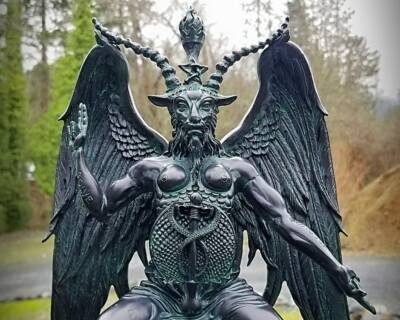Introduction to Baphomet
Baphomet is one of the most enigmatic and misunderstood figures in occultism, mysticism, and popular culture. Associated often with the imagery of a winged, goat-headed figure, Baphomet has been used to symbolize a range of ideas—from balance and duality to accusations of heresy.
In this article, we will explore Baphomet’s origins, historical evolution, symbolic meanings, and its role in modern times.
Table of Contents
The Mysterious Origins of Baphomet
The Knights Templar and Early Mentions
The earliest recorded mentions of Baphomet date back to the early 14th century during the trials of the Knights Templar.
Accused of heresy by King Philip IV of France, members of the Templar Order were alleged to worship a mysterious figure called “Baphomet.”
Many scholars believe “Baphomet” was a corruption of “Mahomet” (an old French version of “Muhammad”), used to accuse the Templars of idolatry and blasphemy.
However, there is little historical evidence that the Templars worshiped any such figure. Most historians agree these accusations were likely fabricated to discredit the Order and justify the seizure of its wealth and power.
Eliphas Levi and the Modern Image
The modern depiction of Baphomet as a goat-headed, androgynous figure comes from Eliphas Levi, a 19th-century French occultist.
In his 1854 book, Dogme et Rituel de la Haute Magie (Dogma and Ritual of High Magic), Levi illustrated Baphomet as a winged humanoid figure with the head of a goat, female breasts, and a torch between its horns.
Levi’s Baphomet was not intended as a representation of evil but rather as a symbol of balance, reflecting the union of opposites: good and evil, male and female, above and below.
Symbolism of Baphomet
The Goat Head
The goat head of Baphomet is often linked to the Goat of Mendes, another occult symbol.
The goat represents fertility, vitality, and primal nature. In the case of Baphomet, it also suggests animal instincts harmonized with spiritual wisdom.
The Torch and Horns
The torch situated between Baphomet’s horns symbolizes divine enlightenment, a key tenet in many mystical traditions.
The horns themselves are ancient symbols of power, virility, and cosmic energy.
The Pentagram
In many depictions, Baphomet’s forehead bears a pentagram. Depending on its orientation (point-up or point-down), the pentagram can signify either protection and balance or materialism and chaos.
In Baphomet’s case, it often points upward, representing spiritual ascent and harmony.
Androgyny and Duality
Baphomet combines male and female features to signify duality and unity.
The figure represents the alchemical marriage—the union of opposites that leads to spiritual transformation.
Its body gestures, particularly the phrase Solve et Coagula (Latin for “dissolve and coagulate”) written on its arms, refer to the alchemical process of breaking down elements and recombining them into something greater.
Baphomet in Popular Culture
Misinterpretations
Over time, Baphomet has been misunderstood and misrepresented, especially by those unfamiliar with its symbolic meaning.
Christian fundamentalists, in particular, have portrayed Baphomet as a Satanic figure, despite the lack of historical connection to Satan worship.
Movies, video games, and literature often depict Baphomet as a demon or evil entity, further cementing its misunderstood reputation in mainstream culture.
The Church of Satan and Baphomet
In 1966, Anton LaVey founded the Church of Satan, adopting Baphomet’s imagery prominently.
The Church’s symbol, known as the “Sigil of Baphomet,” features a goat’s head within an inverted pentagram.
However, LaVey’s use of Baphomet was more symbolic of rebellion against traditional religious structures rather than actual demon worship.
Baphomet in Art and Media
Baphomet has found a place in various artistic expressions, music albums, tattoos, and even fashion.
Artists use Baphomet to symbolize individuality, questioning authority, and exploring spiritual freedom.
Examples include:
- Heavy metal bands incorporating Baphomet into album covers.
- Television series like Sabrina showcasing a Baphomet-like statue.
- Graphic novels and fantasy games using Baphomet as a mystical antagonist.
Modern Symbolism and Meaning
A Symbol of Freedom and Individuality
Today, many see Baphomet as a symbol of personal freedom, balance, and self-deification—an idea where individuals strive to realize their full potential without reliance on external religious doctrines.
Legal Battles and Public Displays
In recent years, groups like The Satanic Temple have used Baphomet statues in legal and political activism.
For example, in response to the erection of Ten Commandments monuments at state capitols in the United States, they proposed installing Baphomet statues to assert religious equality and separation of church and state.
These actions are typically aimed at promoting secularism rather than endorsing Satanism, again showing the symbolic rather than literal role Baphomet plays today.
Common Misconceptions About Baphomet
Baphomet Is Not Satan
Despite popular belief, Baphomet is not Satan.
While it has been adopted into various left-hand path traditions, Baphomet’s original symbolism was more about balance and enlightenment than good versus evil.
Baphomet Worship Is Rare
There is no significant religious sect that actively “worships” Baphomet as a deity.
Its usage is more symbolic in occult traditions, esotericism, and political commentary.
Baphomet and Witchcraft
Though occasionally associated with witchcraft imagery, Baphomet is not a central figure in Wicca or traditional paganism.
Its association with witchcraft mainly stems from misunderstandings and the broader conflation of anything non-Christian with “devil worship.”
The Spiritual Meaning Behind Baphomet
Alchemy and Spiritual Evolution
Baphomet’s symbolism closely mirrors the goals of alchemy—personal transformation, achieving balance, and enlightenment.
The figure itself is a rich tapestry of alchemical, Kabbalistic, and Gnostic references.
By embodying both light and dark, male and female, earthly and divine, Baphomet invites seekers to transcend dualities and reach a higher state of awareness.
Esoteric Interpretations
In esoteric traditions, Baphomet represents the “Perfected Human,” the individual who integrates all aspects of existence and achieves mastery over self.
This is why Baphomet is often shown with one hand pointing up and one hand pointing down: the famous Hermetic axiom “As above, so below.”
Baphomet’s Place in the 21st Century
Spiritual Rebellion
In an age where traditional religious institutions are increasingly questioned, Baphomet stands as a powerful symbol of spiritual rebellion and the pursuit of inner truth.
It encourages individuals to forge their paths and find enlightenment outside dogmatic systems.
Art, Fashion, and Identity
Baphomet’s image continues to be a form of personal and artistic expression for those who embrace nonconformity, freedom, and spiritual exploration.
Whether worn as jewelry, inked in tattoos, or featured in modern artwork, Baphomet transcends its misunderstood origins to become a modern icon.
Conclusion
The story of Baphomet is not one of devil worship, but of mystery, symbolism, and personal enlightenment.
From its first mentions during the trials of the Knights Templar to its modern reinterpretations by artists, activists, and occultists, Baphomet has evolved into a symbol far richer and more complex than often portrayed.
Understanding Baphomet requires moving beyond surface-level associations and exploring the deeper meanings of duality, balance, and spiritual transformation.
In doing so, we not only appreciate its historical significance but also recognize its enduring relevance in today’s quest for meaning and individuality.






